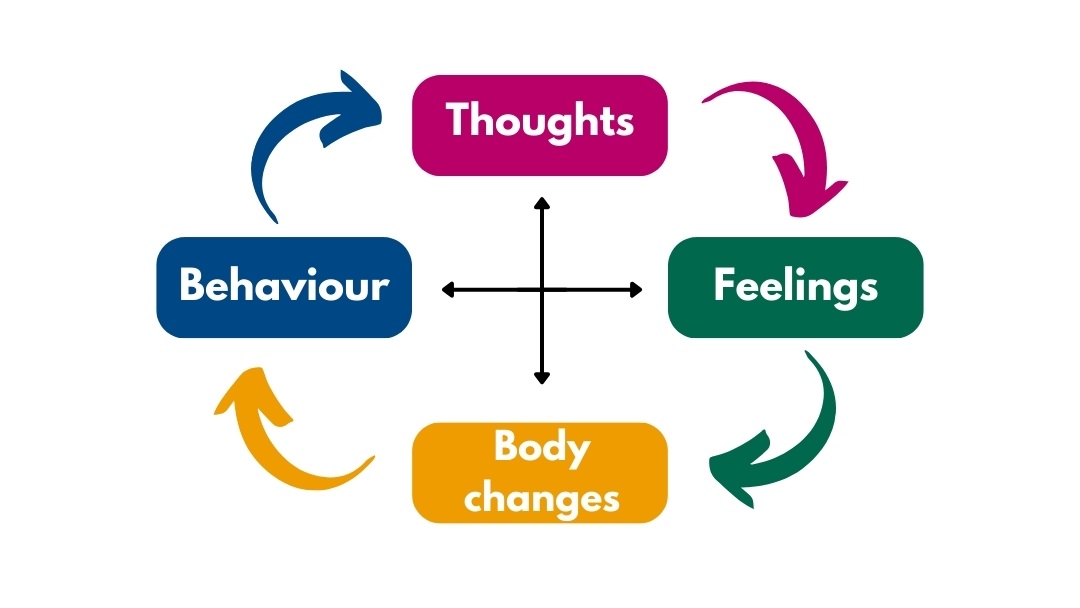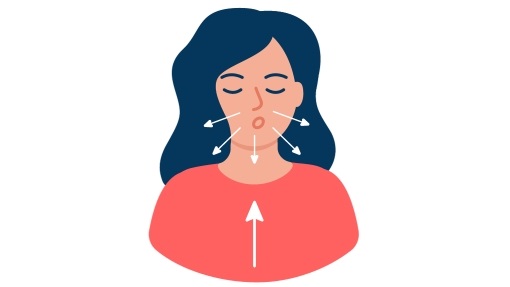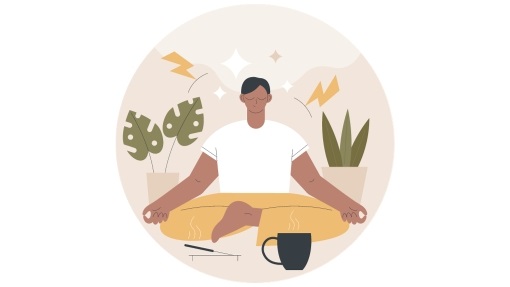Managing my Anxiety
Section one: Introduction and module aims
Introduction
This module will look at anxiety. It will give you guidance and information on further resources to help you manage this.
Aims of the module
This module aims to:
- Help you understand more about what anxiety is and how it can be common after brain injury
- Help you to identify how anxiety affects you (what symptoms you may have)
- Introduce things that you can try to help manage your anxiety
- Give you details of other resources that will give you more information to help you with your anxiety
Section two: What is anxiety?
Anxiety is an unpleasant feeling that everyone feels sometimes. Other words used to describe it are: feeling nervous, uptight, irritable, wound up, or tense.
It is normal to have short periods of anxiety. This is part and parcel of everyday life. Sometimes though, anxiety can hang around for longer periods of time and become a problem.
What causes anxiety after brain injury?
Having a brain injury is usually sudden and unexpected. It can cause huge changes to a person’s life.
People who have had a brain injury can have many different things that make them feel stressed all at once. For example, you might have changes in your employment, financial problems, relationship changes and health worries.
When you are faced with lots of change in a short space of time, it is understandable that you become anxious. Anxiety is often the result of feeling that things are out of your control and that you cannot cope with the demands placed upon you.
What keeps Anxiety Going?
Anxiety can make it harder for you to think clearly and can result in a vicious cycle.
The vicious cycle of anxiety

Thoughts
When we are anxious, our thinking can become more negative. We can have lots of unwelcome negative thoughts that pop into our minds about a variety of things. We can start to expect that the worst possible outcome will always happen. We can have negative thoughts about an outcome that will always happen. We can also have negative thoughts about:
- Ourselves – “I keep forgetting things, I’m so stupid”, “I’m a burden to everyone”
- Others – “They think I’m lazy”, “They won’t want to spend time with me”
- The future – “What if I have another injury to my head…I might die”, “I’ll never be able to work again”
Feelings
Negative thoughts can lead to a change in our emotions, making us feel upset, scared, angry, uptight etc.
Body Changes
Our flight or flight response can be triggered and we can experience a variety of uncomfortable physical sensations such as faster breathing and heart rate, feeling hot, tense, dizzy and sick. We can worry that these symptoms mean there is something wrong with our health and this can feed into our anxiety making us feel worse. In reality, these symptoms are harmless and happen because the body is trying to keep us safe. Anxiety can also affect our bodies in other ways such as increasing or decreasing our appetite or making it hard to get to sleep.
Behaviour
Anxiety can lead us to change how we behave by avoiding things. We may avoid going out alone because we are worried about falling. We may avoid seeing friends as we worry that we may trip over our words and embarrass ourselves. We can stop doing lots of things that we used to enjoy. Avoiding things means that we never get to see that things would often go better than our minds tell us they will! This helps to keep anxiety going.
When we look closely at anxiety, we can begin to see that our thoughts, emotions, body changes and how we behave all work together to keep our anxiety going.
Section three: How does anxiety affect your body?
Fight or Flight
When you are anxious you can feel a variety of uncomfortable physical sensations. While anxiety feels uncomfortable, it is your body’s way of protecting you.
You might have heard of the ‘Fight or Flight’ response. This is how your body responds in stressful situations. When you are facing a threat to your safety, the fight or flight response is automatically triggered. It allows you to survive a threatening situation by getting your body in the best physical state to fight or to run.
- The fight or flight response was even more important many years ago when the first humans were on earth. They had a much more dangerous lifestyle than we have today and often faced threats from predators!
- The fight or flight response was essential in helping humans to protect themselves. Today life is safer and the fight or flight response is needed less but unfortunately our bodies and minds have not caught up. This means the fight or flight response can happen in situations where it is not needed and is not helpful! For example, if you are worrying about your finances, it is not helpful for your body to be ready to fight or run away from them.

You can feel a range of uncomfortable physical sensations in your body when you are anxious. These happen because your body is preparing for action. You can see these physical changes in the illustration below:
When you have these uncomfortable symptoms, you might worry that they are harmful or might be a sign that something is wrong with your health. For example, people can worry they are having a heart attack or a stroke. These fears can make your anxiety worse and keep it going for longer.
It is important to remember that anxiety is actually designed to protect us and is not harmful. Understanding anxiety and the symptoms it causes can help you to worry less about them.
Section four: Ways to help your anxiety
Strategies to help you manage anxiety
Once you understand more about what the symptoms of anxiety are, there are many strategies you can start using to reduce your anxiety.
Below is a summary of strategies to help you to manage your anxiety. There are links to useful websites to help you to begin practicing these strategies.
Challenge your thoughts
- We often believe the thoughts that our anxious brain is telling us.
- These thoughts are often unhelpful, worrying, and can keep you in a cycle of feeling anxious.
- But, an important step is to begin to notice what your worrying thoughts are. If you can label your worrying thoughts, this gives you the power to begin to challenge them!
Learn how to feel more relaxed (physically and mentally)
- Anxiety can make you feel physically tired (due to tense muscles, having to be constantly ‘prepared’ for bad things to happen)
- It can also make you feel mentally tired (due to constantly worrying, having to be on ‘alert’).
- But, there are exercises you can practise to begin to relax your body and mind such as Breathing exercises and Progressive Muscular Relaxation

Learn how to shift your mind from constant anxious/worrying thoughts
- ‘Worry time’: Allow yourself a certain amount of time per day when you can think about your worries. You could write them down. Once this time has ended, focus on the rest of your day
- Distraction: Learn to shift your busy, worrying mind by using mental exercises to distract you from these worries
- Grounding: Often anxiety can be like a time-travelling machine. We can think about something that has already happened in the past (and can’t be changed), or worry about things that may happen in the future. Learning grounding strategies can help to bring you back to the ‘here and now’.
- Problem-solving: Feelings and thoughts of anxiety can make things feel overwhelming. This can make you avoid things and continue to ruminate (dwell on the problem). It can help to learning problem-solving techniques. These can help to break down tasks and make them feel more manageable.
Visit NHS Inform for more detailed explanations and examples of each of the strategies
Begin to identify the things you have been avoiding due to your anxious thoughts
- Tackle this in a manageable way: Visit NHS Inform for ways to begin to identify and introduce the things you have been avoiding
Please note: It is useful to start by trying one strategy at a time. Please read/listen to the two examples below:
Example 1
Bob was involved in a road traffic accident which caused him to have a brain injury and broken legs. He spent all his time at home as his legs recovered. He began to feel better physically and his walking got back to normal but he was feeling very anxious about leaving his house.
Whenever his wife suggested they go to the supermarket together he would begin to feel very sweaty, his heart would beat faster, and his breathing became quicker. He had anxious thoughts about whether other people would be looking at him and know he had experienced a brain injury. He worried about what they may be thinking about him. This meant that Bob was avoiding doing anything that could bring on these unpleasant feelings, including going out with his wife, meeting friends or going to the gym.
Bob knew that this was making him feel even worse as he was no longer doing anything that he enjoyed before. He decided to start trying to manage his anxiety.
First, he read about anxiety symptoms, so that he could identify the ones he experienced. He found out that these were common, and not a sign that something was wrong in his body.
Then he began to make a list of the things he was avoiding that were important to him. As a first step, he set himself a goal to be able to return to the gym alone.
1st Strategy: He began to practice breathing exercises and relaxation exercises at home regularly, so that he could understand how it felt to be relaxed.
2nd Strategy: Once Bob felt he knew how to relax his body when he was feeling tense/anxious, he then began to write down the worrying thoughts he had whenever he thought about leaving his home and going to the gym. Once he had identified all these anxious thoughts, he was then able to start challenging them.
3rd Strategy: He then thought about which aspects of going to gym made him feel most and least anxious. This was so that he could start building his confidence by beginning with the easier situations first. E.g. He started by going with a friend, and going at times when he knew the gym would likely be less busy. This gave Bob the opportunity to use his breathing exercises and tackle his anxious thoughts.
Bob was able to see that doing the actual activity was never as difficult as his anxious thoughts would have him believe. His confidence grew so that over time he was able to return to the gym alone. He realised that he also felt better now that he had returned to exercise.
As Bob became more confident managing his anxious thoughts and feelings, he was able to think about other activities that he was avoiding. He made another list and he was able to tackle these and build confidence so that he was spending less time at home.
Example 2
Eileen was a nursery teacher who had a ruptured aneurysm (sudden bleed) in her brain. Although she recovered well and was able to return to work after several months, she began to have a lot of worrying thoughts about whether this could happen again. She also worried that this was affecting her work, as she often felt tired and mentally exhausted.
First, Eileen read about anxiety symptoms, so that she could understand more about common anxious thoughts that someone can have.
1st Strategy: Eileen began to make a list of the worrying thoughts that she was having. From this, she was then able to begin to challenge them (e.g. her neurosurgeon had reassured her that surgery had gone well, and they didn’t have any concerns that there was anything wrong in her brain).
2nd Strategy: Eileen began to use distraction and grounding techniques at times when she realised she was being caught up in worries.
3rd Strategy: Eileen had practised mindfulness in the past, and she returned to practising this regularly. This helped her to be in the present, rather than being caught up in worries about the past or future.
Using these strategies, Eileen began to realise over time that she was spending less of her day worrying, and had more energy to enjoy her time at work and home.
Take a moment
Now that you have read through the various strategies that can be helpful in managing feelings of anxiety, take some time think:
- What are your specific anxiety symptoms? (i.e. what distresses you the most?)
- What strategy do you want to try to help with this?
- How would you know that you are managing your anxiety better? Set yourself a goal!
Now that you’ve completed this module, please take a moment to rate your knowledge and confidence in how you can manage your anxiety.
Resources
Below are useful links for resources to learn more ways of coping with anxiety and stress:
- NHS Inform: https://www.nhsinform.scot/illnesses-and-conditions/mental-health/mental-health-self-help-guides/anxiety-self-help-guide
- Moodjuice: http://www.moodjuice.scot.nhs.uk
- Headway: Managing anxiety after brain injury – https://www.headway.org.uk/about-brain-injury/individuals/brain-injury-and-me/managing-anxiety-after-brain-injury/
- Scottish Acquired Brain Injury Network (SABIN): https://www.acquiredbraininjury-education.scot.nhs.uk/impact-of-abi/psychological-and-psychiatric-difficulties/anxiety/
- SABIN Phobic Anxiety resource: https://www.acquiredbraininjury-education.scot.nhs.uk/impact-of-abi/psychological-and-psychiatric-difficulties/anxiety/phobic-anxiety-disorder/
- Lanarkshire Mind Matters offers a range of online courses from NHS Lanarkshire Psychological Services. Some need you to be referred by your G.P. or another healthcare professional and you can self-refer to others:
- Calm Distress: It is all about getting to know our emotions, learning new ways to cope, and improving our wellbeing. Involves five online videos (lasting approximately 20 minutes each) providing lots of useful information. There are booklets to go alongside the videos, which can be downloaded to allow you to keep track of your progress.
- Online cognitive behavioural therapy (CBT) courses – CBT is a popular, effective therapy that teaches new ways of identifying and responding to thoughts and emotions. NHS Lanarkshire offers a range of computerised CBT (cCBT) courses: SilverCloud (courses on resilience, sleep and stress are available by self-referral). You can also self-refer to join Daylight (an app for anxiety and worry designed for the smartphone) and Sleepio (an app to aid sleep).
- You will need a G.P./ healthcare professional referral to access SilverCloud courses on health anxiety, social anxiety, phobia, panic and OCD.
- Mindfulness Scotland link for access to free audio resources to practice Mindfulness: https://www.mindfulnessscotland.org.uk/audio-practices.html


